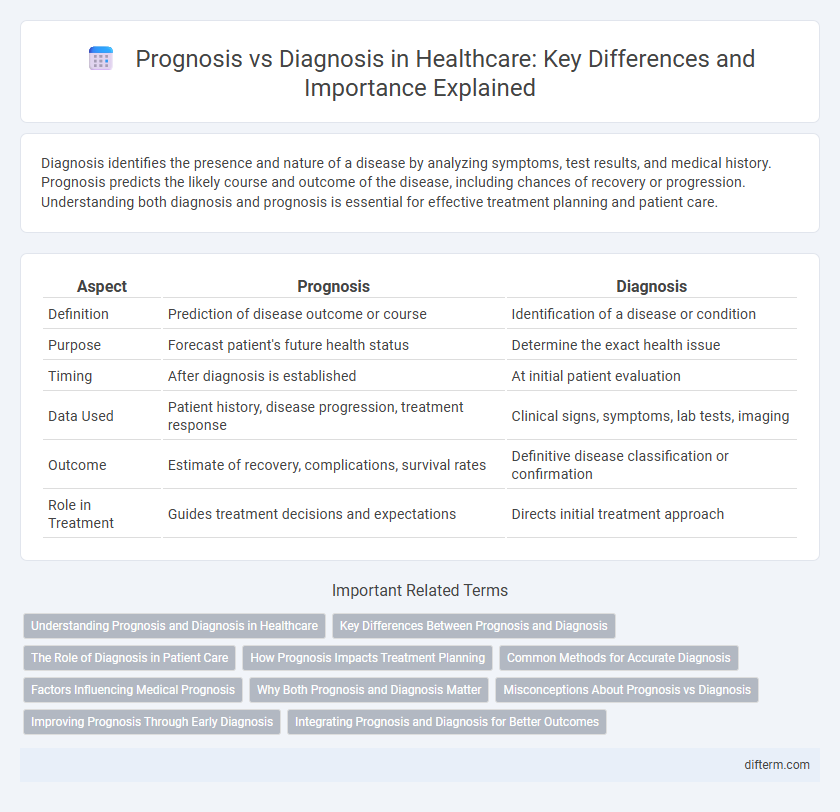Diagnosis identifies the presence and nature of a disease by analyzing symptoms, test results, and medical history. Prognosis predicts the likely course and outcome of the disease, including chances of recovery or progression. Understanding both diagnosis and prognosis is essential for effective treatment planning and patient care.
Table of Comparison
| Aspect | Prognosis | Diagnosis |
|---|---|---|
| Definition | Prediction of disease outcome or course | Identification of a disease or condition |
| Purpose | Forecast patient's future health status | Determine the exact health issue |
| Timing | After diagnosis is established | At initial patient evaluation |
| Data Used | Patient history, disease progression, treatment response | Clinical signs, symptoms, lab tests, imaging |
| Outcome | Estimate of recovery, complications, survival rates | Definitive disease classification or confirmation |
| Role in Treatment | Guides treatment decisions and expectations | Directs initial treatment approach |
Understanding Prognosis and Diagnosis in Healthcare
Diagnosis identifies the nature and cause of a patient's illness based on symptoms, tests, and medical history, providing the foundation for effective treatment. Prognosis estimates the likely course, duration, and outcome of the disease, helping healthcare professionals and patients make informed decisions about management and expectations. Clear communication of diagnosis and prognosis enhances patient care by guiding treatment plans and supporting emotional readiness.
Key Differences Between Prognosis and Diagnosis
Diagnosis identifies the nature and cause of a patient's illness through clinical evaluation and tests, establishing the current health condition. Prognosis predicts the likely course, outcome, and potential complications of the diagnosed disease, providing insights into recovery chances and life expectancy. Understanding these key differences aids healthcare professionals in treatment planning and patient communication.
The Role of Diagnosis in Patient Care
Diagnosis is essential in patient care as it identifies the specific illness or condition affecting the individual, enabling tailored treatment plans that improve health outcomes. Accurate diagnosis utilizes clinical evaluations, laboratory tests, and imaging to establish the root cause of symptoms, guiding appropriate interventions. Early and precise diagnosis reduces complications, supports effective disease management, and enhances overall patient prognosis.
How Prognosis Impacts Treatment Planning
Prognosis provides critical insights into the likely course and outcome of a disease, guiding clinicians in tailoring personalized treatment plans that optimize patient outcomes. Accurate prognostic information helps determine the intensity and duration of therapies, balancing potential benefits with risks to avoid overtreatment or undertreatment. Integrating prognosis into treatment planning enhances decision-making by predicting disease progression, response to interventions, and overall survival rates.
Common Methods for Accurate Diagnosis
Common methods for accurate diagnosis in health include physical examinations, laboratory tests, and medical imaging techniques such as X-rays, MRIs, and CT scans. Diagnostic tools such as blood tests, biopsies, and genetic screening provide essential data to identify the presence and nature of diseases. Accurate diagnosis relies on combining clinical findings with diagnostic technology to guide effective treatment plans and inform prognosis.
Factors Influencing Medical Prognosis
Medical prognosis is influenced by factors such as the patient's age, overall health, and stage of the disease at diagnosis. Genetic predispositions, response to treatment, and presence of comorbid conditions also play critical roles in determining the likely course and outcome of an illness. Accurate prognosis requires continuous assessment and integration of clinical data, laboratory results, and imaging studies.
Why Both Prognosis and Diagnosis Matter
Diagnosis identifies the specific disease or condition affecting a patient, offering clarity for targeted treatment plans, while prognosis provides an informed prediction about the likely course and outcome of the illness. Both prognosis and diagnosis matter because accurate diagnosis ensures appropriate medical intervention, and prognosis helps patients and healthcare providers set realistic expectations for recovery and long-term management. Together, they enable comprehensive care by combining precise identification of health issues with strategic planning for future health outcomes.
Misconceptions About Prognosis vs Diagnosis
Misconceptions about prognosis versus diagnosis often confuse patients, as diagnosis identifies the presence of a disease while prognosis predicts its likely course and outcome. Many assume that a diagnosis alone can determine treatment success, overlooking that prognosis incorporates factors like patient age, disease stage, and overall health. Clarity in understanding the distinction between these terms enhances informed decision-making and realistic expectations in healthcare.
Improving Prognosis Through Early Diagnosis
Early diagnosis significantly improves prognosis by enabling timely intervention and treatment, reducing the progression of diseases such as cancer, diabetes, and cardiovascular conditions. Detecting illnesses in initial stages allows for more effective management strategies, lowering morbidity and mortality rates. Incorporating advanced diagnostic tools like imaging, biomarkers, and genetic testing enhances accuracy and supports personalized medicine approaches.
Integrating Prognosis and Diagnosis for Better Outcomes
Integrating prognosis and diagnosis enhances patient care by combining accurate disease identification with predictions about disease progression and outcomes. This approach enables personalized treatment plans that address both current conditions and future health risks, improving long-term management. Healthcare providers can leverage combined data to optimize interventions, reduce complications, and promote better overall health outcomes.
Prognosis vs Diagnosis Infographic

 difterm.com
difterm.com